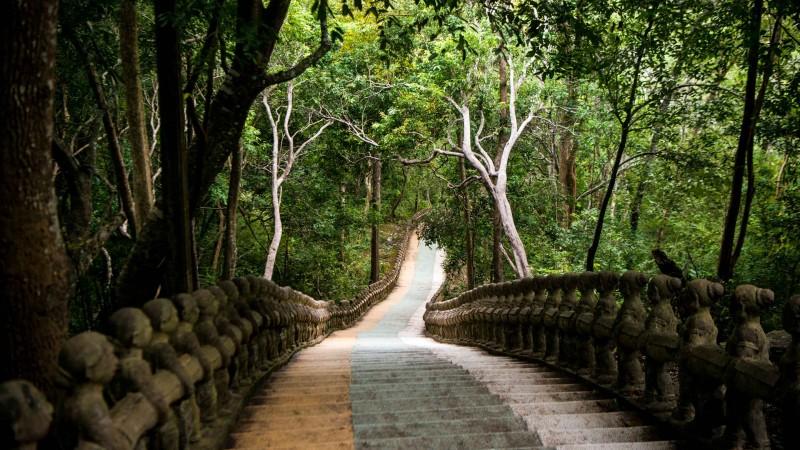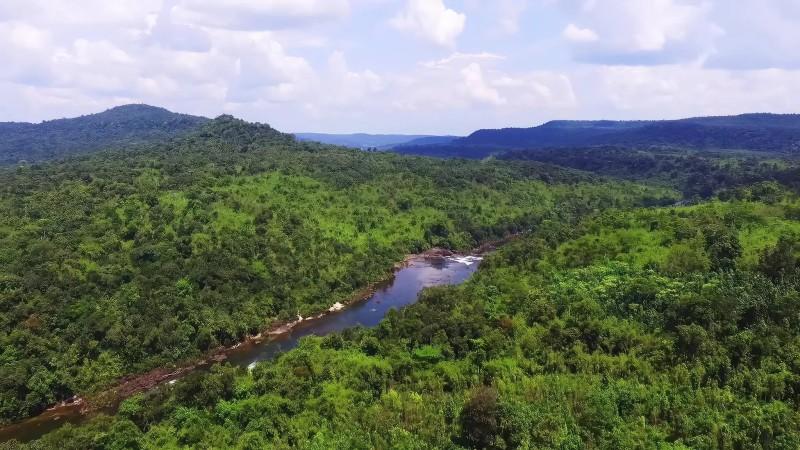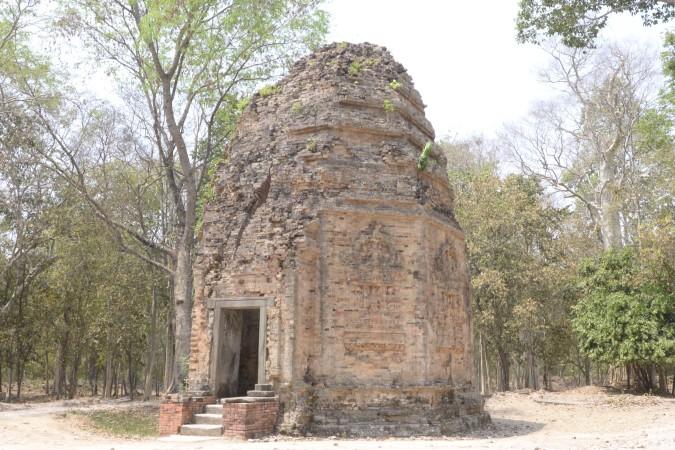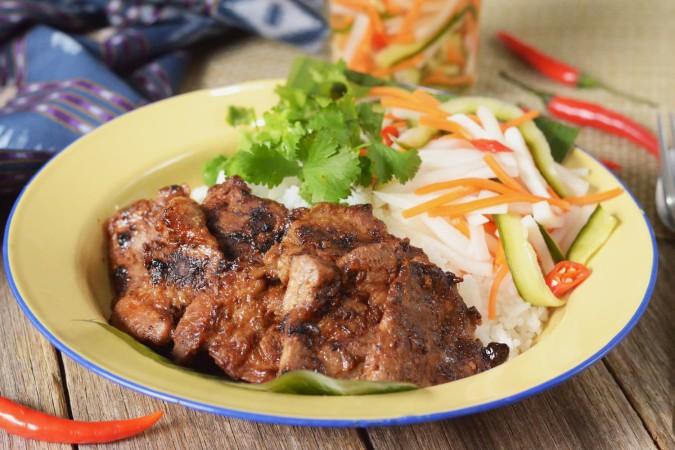Kampong Thom travel - Cambodia, Asia
Situated approximately 168 kilometers from Phnom Penh and 150 kilometers from Siem Reap, making it a convenient stop for travelers between these two major cities, Kampong Thom is a province located in central Cambodia, known for its rich historical significance and cultural heritage. The province covers an area of about 15,061 square kilometers and is bordered by several provinces, including Preah Vihear, Siem Reap, and Kampong Cham. It features a mix of low-lying plains, forests, and significant water bodies, including parts of the Tonle Sap basin.
Population: Approximately 700,000 in 2024.
Economy: Kampong Thom's economy is characterized by its agricultural richness, particularly in rice and cashew production, alongside a growing tourism sector that highlights its historical and natural attractions. This economic diversity not only supports local livelihoods but also enhances the overall visitor experience in the region.
Landmarks: Sambor Prei Kuk Temples, Prasat Tao, Prey Pros, Kampong Thom Museum, Wat Prasat (Prasat Temple), Tonle Sap Lake
Cambodia

Overview of Kampong Thom
History & Culture Influence
Kampong Thom is one of Cambodia's oldest inhabited regions, with evidence of human settlement dating back over 2,000 years. It was a powerful center during the Funan period, around the 1st century AD, and later became an important city of the Chenla Kingdom, serving as a precursor to the Khmer Empire. The ancient city of Sambor Prei Kuk, a UNESCO World Heritage site, features around 200 brick temples built during this time, showcasing the region's historical importance as a cultural and religious center.
During the Khmer Empire (9th to 15th centuries), Kampong Thom flourished as a hub for trade and culture. The province was known for its architectural achievements, including the construction of significant temples that influenced later Khmer architecture, particularly those found in the Angkor complex.
The region faced turmoil after the fall of the Khmer Empire, enduring conflicts between the Thais and Vietnamese. In the 1800s, it became part of French Indochina, which led to administrative changes and the establishment of modern infrastructure.
Kampong Thom's cultural landscape is characterized by a blend of its historical roots and contemporary Khmer traditions. The province is home to various ethnic groups, including the Stieng, who have largely assimilated into Khmer society. This cultural diversity is reflected in local customs, festivals, and traditional crafts.
Interaction with The Locals
Predominantly comprising ethnic Khmers, Kampong Thom also includes various ethnic minorities, such as the Stieng, who contribute to the cultural diversity of the area. This mix of ethnic groups enriches the local customs, traditions, and daily life. Locals in Kampong Thom are generally very welcoming and friendly towards tourists. They often appreciate visitors who show interest in their culture and way of life. Many residents are eager to share stories about their traditions, agriculture, and local crafts. Visitors are encouraged to be respectful of local customs and traditions. This includes dressing modestly, especially when visiting temples or rural areas, and being mindful of social norms, such as removing shoes before entering homes or sacred sites.

Kampong Thom nature - © walkaboutmonkey
Top Attractions in Kampong Thom
Kampong Thom, offers a rich tapestry of cultural and natural attractions. Here’s a list of top attractions in Kampong Thom that you should visit:
Prasat Sambor Prei Kuk
Location: About 30 km north of Kampong Thom city
Step back in time at Prasat Sambor Prei Kuk, an extraordinary complex of pre-Angkorian temple ruins that dates back to the Chenla era, from the late 6th to the 9th centuries. This UNESCO World Heritage site is a hidden gem featuring dozens of brick temples nestled within the lush forest. As you wander through this archaeological treasure, you'll encounter some of the earliest examples of Khmer architecture, providing a glimpse into the rich history and artistry of the Khmer Empire.
Tonlé Sap Biosphere Reserve
Location: Western part of Kampong Thom province
Explore the remarkable Tonlé Sap Biosphere Reserve, part of Southeast Asia's largest freshwater lake. This unique ecosystem includes two core areas in Kampong Thom: Boeng Chhmar, covering an impressive 14,560 hectares, and Stung Saen, spanning 6,355 hectares. Known for its rich biodiversity, this reserve is home to floating villages where you can experience the local lifestyle and stunning natural beauty that thrives along the water.
Stung Sen River
Location: Runs through Kampong Thom city
Stung Sen River is not just a vital water source; it's also a picturesque attraction that winds its way through Kampong Thom city. With the provincial capital, Stung Saen, sitting alongside its banks, this river offers plenty of opportunities for boat rides and relaxing riverside strolls. Whether you’re looking to unwind or soak in the scenery, the Stung Sen River is a perfect spot to enjoy the tranquility of nature.
Prasat Andet
Location: Kampong Svay district, about 40 km east of Kampong Thom city
Discover the lesser-known yet stunning Prasat Andet, another significant Angkorian temple site that’s well worth a visit. Located about 40 km east of Kampong Thom city, this site features several impressive brick towers that showcase the evolution of Khmer temple architecture. Although it attracts fewer visitors than Sambor Prei Kuk, its historical significance and architectural beauty make it a hidden treasure for history enthusiasts.
Santuk Silk Farm
Location: Near Santuk Mountain, about 30 km south of Kampong Thom city
Experience the art of traditional silk-making at Santuk Silk Farm, located near the breathtaking Santuk Mountain. This cultural attraction allows visitors to immerse themselves in the silk production process, from mulberry cultivation to weaving. Take a guided tour to see the intricate techniques involved in creating beautiful silk textiles, and perhaps even purchase some exquisite souvenirs to take home.

Sambor Prei Kuk Temples - © So Sokun Theary
Must-Try Dishes in Kampong Thom
Kampong Thom offers a delectable array of local specialties that showcase the region's rich culinary heritage. Here are some must-try dishes when visiting this vibrant area:
Fish Amok
Fish Amok is a quintessential Khmer curry dish crafted with freshwater fish, coconut milk, kroeung (a spice paste), and kaffir lime leaves, delivering a creamy and aromatic flavor. Traditionally served in a banana leaf cup, this dish is a culinary staple in Cambodia, especially in Kampong Thom due to its close proximity to Tonle Sap Lake and the plentiful supply of freshwater fish in the region.
Nom Banh Chok
Known as a cherished breakfast in Cambodia, Nom Banh Chok consists of fresh rice noodles topped with a fish-based green curry sauce, assorted vegetables, and herbs, often garnished with crispy fried fish. As a national dish, it highlights the region’s abundant rice production and the centrality of fish in the local diet, providing a glimpse into the everyday culinary practices of Cambodian people.
Bai Sach Chrouk
Bai Sach Chrouk, a popular Cambodian breakfast dish, features grilled pork and broken rice accompanied by pickled vegetables, a boiled egg, and sweet and sour sauce. This dish reflects the country's French colonial legacy, utilizing broken rice—a byproduct of rice milling—and combines it with local flavors to create a fulfilling morning meal.
Lap Khmer
Lap Khmer, a spicy beef salad, is made with thinly sliced raw beef mixed with herbs, vegetables, and a tangy dressing. This dish exemplifies Cambodia's preference for fresh ingredients and robust flavors, highlighting the versatility of beef within the local cuisine and offering a flavorful insight into the regional palate.
Bok L'hong
Bok L'hong, a vibrant green papaya salad, combines shredded unripe papaya with tomatoes, chilies, pounded prahok (fermented fish), lime juice, and sugar. This popular appetizer or side dish is frequently served with grilled meats or fish, showcasing Cambodia’s affinity for fresh, crunchy textures and intense, zesty flavors, characteristic of the local culinary landscape.

Bai Sach Chrouk - © gather
Festivals & Local Celebrations
With a rich cultural experience, showcasing the traditions and community spirit of Kampong Thom while offering opportunities to engage with locals and participate in the celebrations. These are must try festivals for the best cultural experience:
Water Festival (Bon Om Touk)
Time of Year: Typically held in November
This festival celebrates the reversing of the Tonle Sap River's flow and includes vibrant boat races along the Stung Sen River. Visitors can expect lively festivities, traditional music, and food stalls, creating a festive atmosphere that showcases local culture.
River Festival
Time of Year: Annually, usually in March
The River Festival highlights the importance of rivers in Cambodian culture and ecology. It features exhibitions of local agricultural products, traditional performances, and various activities along the riverbanks. Visitors can enjoy boat races, food tastings, and cultural demonstrations, making it a vibrant celebration of community and nature .
Khmer New Year (Chaul Chnam Thmey)
Time of Year: Celebrated in mid-April
A significant cultural festival marks the Cambodian New Year and is celebrated with various traditional rituals, including visiting temples, making offerings, and participating in community games. Visitors can experience local customs, traditional dances, and festive foods during this joyful time.
Pchum Ben Festival
Time of Year: Typically occurs in September or October
Pchum Ben is a religious festival honoring deceased ancestors. Locals visit pagodas, offer food to monks, and participate in prayers. Visitors can observe the spiritual practices and community gatherings that highlight the importance of family and remembrance in Cambodian culture.
Sangkranta Festival
Time of Year: Celebrated in early April, coinciding with Khmer New Year
Characterized by water fights, traditional games, and cultural performances. Visitors can join in the fun, enjoy local delicacies, and witness the vibrant celebrations that bring together the community in a festive spirit at Sangkranta Festival.

Pchum Ben Festival - © gather
Weather in Kampong Thom
Kampong Thom experiences a tropical climate characterized by distinct wet and dry seasons. Here’s an overview of the weather patterns, average temperatures, rainfall, and the best times to travel to help visitors pack appropriately.
Average Temperatures
- Winter (December to February): Average temperatures range from 22°C to 28°C (72°F to 82°F). December is the coolest month, with temperatures averaging around 26°C (79°F).
- Spring (March to May): Temperatures rise, with averages between 25°C and 34°C (77°F to 93°F). March is the hottest month, reaching up to 30°C (86°F) during the day.
- Summer (June to August): Average temperatures range from 24°C to 32°C (75°F to 90°F). This period is marked by higher humidity and increased rainfall.
- Autumn (September to November): Temperatures begin to cool slightly, averaging between 23°C and 31°C (73°F to 88°F). October sees a gradual decrease in rainfall as the dry season approaches.
Rainfall
- Annual Rainfall: Kampong Thom receives significant rainfall, particularly during the wet season from May to October. The wettest months are August and September, with average precipitation exceeding 200 mm (7.9 inches).
- Dry Months: The driest months are January and February, with rainfall averaging around 10 mm (0.4 inches) in January, making it an ideal time for travel.
Best Time to Travel
- December to February: This is considered the best time to visit Kampong Thom, as the weather is cooler and drier, making it suitable for outdoor activities and sightseeing.
- March to May: While temperatures can be higher, this period is still manageable for travel, especially in early March before the peak heat of April.
- June to October: This period marks the rainy season, with increased humidity and frequent showers. While the landscape is lush and green, travelers should be prepared for wet conditions.
Weather Patterns
- Humidity: Humidity levels are generally high, especially during the rainy season, which can make temperatures feel warmer.
- Sunshine: The region enjoys ample sunshine, with the sunniest months typically being December through February.

Prasat Yeai Poeun carvings - © gather
Cultural etiquette when visiting Kampong Thom
When visiting Kampong Thom, understanding and respecting local customs and etiquette is essential for a positive experience. Here are some important cultural practices and customs to be aware of:
Greetings
- Sampeah: The traditional Cambodian greeting involves placing your palms together at chest level and bowing slightly. The height of your hands indicates the level of respect you are showing, with higher hands reserved for those of higher status, such as monks or elders. While handshakes are common among men, women may prefer the sampeah greeting.
Respect for Elders and Monks
- Showing Respect: Cambodians place a high value on respect for elders. When addressing older individuals, use polite language and proper titles, and avoid interrupting them. It is customary to bow slightly when greeting them.
- Monks: Monks are highly revered in Cambodian society. Women should avoid touching monks or their robes, and when giving something to a monk, it’s best to hand it to a male who can pass it on or use a cloth to avoid direct contact.
Dress Code
- Modest Attire: When visiting temples or interacting with locals, dressing modestly is crucial. Women should cover their shoulders and wear knee-length skirts or shorts. Men should also dress conservatively. This shows respect for local customs and the sacredness of religious sites.
Visiting Homes
- Removing Shoes: It is customary to remove your shoes before entering someone’s home. Bringing a small gift, such as fruit or sweets, is also a thoughtful gesture when visiting.
Dining Etiquette
- Seating Arrangements: When dining, wait for the host or the eldest person at the table to start eating before you begin. Be mindful of seating arrangements, as they often reflect social hierarchies.
- Utensil Use: Cambodians typically use a spoon and fork for eating. The fork is used to push food onto the spoon, which is then used to eat.

Tonle Sap Lake floating villages - © The Scrapbook Of Life
Essential Travel Information
Transportation
Airport Transfers
Phnom Penh International Airport (PNH): Private taxi transfers are available from Phnom Penh Airport to Kampong Thom, taking approximately 2.5 to 3 hours depending on traffic. These transfers are comfortable, reliable, and available 24/7.
Public Transit
Buses: Kampong Thom has a local bus system that connects the city to nearby towns and villages. Buses are an affordable way to explore the area, with routes to popular attractions like Sambor Prei Kuk and Phnom Santuk.
Taxis
- Local Taxis: Taxis are readily available in Kampong Thom and provide a convenient way to navigate the city. They can be hailed on the street or booked via phone. Taxi fares within the city are generally reasonable.
- Long-Distance Taxis: Private taxi transfers are available from Kampong Thom to other major cities like Phnom Penh and Siem Reap. These transfers offer a comfortable and reliable option for longer journeys.
Ride-Sharing Services
Ride-sharing services like PassApp and Grab are available in Kampong Thom, providing an alternative to traditional taxis. These services can be booked through their respective mobile apps.
Getting Around Kampong Thom
- Walking: Kampong Thom's city center is compact and walkable, making it easy to explore on foot. Many attractions, such as the Old Colonial Governor's Mansion and the Kampong Thom Museum, are within walking distance of each other.
- Bicycle: Renting a bicycle is a popular way to explore the city's surroundings and nearby attractions like Sambor Prei Kuk. Several hotels and guesthouses offer bicycle rentals for guests.
ATM and Banking Services
PPCBank Kampong Thom Provincial Branch
Offers a range of banking services, including ATMs for cash withdrawal and banking transactions. It provides a convenient option for both locals and visitors to manage their finances.
ACLEDA Bank
One of the largest banks in Cambodia, ACLEDA Bank offers ATMs and various banking services, including personal and business loans, savings accounts, and money transfers.
Woori Bank
Provides a variety of banking services, including ATMs, savings accounts, loans, and money transfers. Woori Bank is known for its customer service and accessibility.
Wing Bank
Known for its digital banking services, Wing Bank offers ATMs and a range of financial solutions, including money transfers, savings, and loans. It is particularly popular for mobile banking services.
Accommodation Choices
Kampong Thom Village Hotel
A comfortable hotel offering modern amenities, including free Wi-Fi, a restaurant, and easy access to local attractions. It provides a cozy atmosphere for travelers.
Sambor Village Hotel
Located near Sambor Prei Kuk, this hotel offers a blend of traditional Khmer hospitality and modern comfort. It features a swimming pool, restaurant, and tour services.
Guesthouses and Homestays
Various guesthouses and homestays are available throughout Kampong Thom, providing a more local experience. These accommodations often feature traditional Khmer architecture and offer opportunities to interact with local families.
Motels
Budget-friendly motels are available in Kampong Thom, providing basic amenities and comfortable lodging for travelers seeking economical options.
Bungalows and Eco-Lodges
For those looking for a unique experience, Kampong Thom offers bungalows and eco-lodges near natural attractions, allowing visitors to enjoy the region's beauty while staying close to nature.
Articles for you

Explore Yala National Park - Sri Lanka Travel, Asia
Tucked away in Sri Lanka’s southeastern corner, Yala National Park is where wild nature meets deep tradition. Known worldwide for its leopard population, the park is also home to elephants, sloth bears, crocodiles, and hundreds of bird species. Beyond wildlife, Yala opens doors to a cultural landscape dotted with ancient temples, Buddhist ruins, and coastal villages. For travelers seeking more than just a safari, Yala offers a chance to explore eco-tourism, local communities, and sacred heritage sites.
Population: The Yala National Park area doesn’t have a human population.
Economy: The economy around Yala National Park thrives on a blend of eco-tourism, agriculture, and local services. Safari tours, eco-lodges, and cultural experiences drive steady income for nearby towns like Tissamaharama and Kataragama, supporting thousands of families.
Landmarks: Famous for Block I of Yala and wildlife encounters, including elephants, sloth bears, crocodiles, and exotic bird species.

Explore Galle - Sri Lanka Travel, Asia
Nestled on Sri Lanka’s southern coastline, Galle is a vibrant city where history meets the sea. Its cobbled streets, colonial architecture, and serene beaches make it a must-visit destination for travelers seeking a blend of culture, adventure, and relaxation. A UNESCO World Heritage site, Galle captivates visitors with its Dutch Fort, bustling markets, and friendly locals. Whether you’re exploring the ramparts at sunset or savoring fresh seafood by the shore, Galle promises an unforgettable journey into Sri Lanka’s heritage.
Population: Approximately 113,000 in 2023.
Economy: Galle’s economy thrives on tourism, trade, and fisheries. The city’s historic fort, colonial architecture, and coastal charm draw thousands of international visitors each year, making tourism its main economic driver. Fishing remains vital for local livelihoods, supplying fresh seafood across the region.
Landmarks: Famous for the Galle Fort, Dutch Reformed Church & Maritime Museum, and Unawatuna Beach.

Explore Bentota - Sri Lanka Travel, Asia
Nestled along Sri Lanka’s southwestern coast, Bentota is a tropical paradise that blends golden beaches, vibrant culture, and thrilling adventures. Famous for its calm waters, luxury resorts, and scenic river estuary, Bentota has become a top destination for travelers seeking both relaxation and authentic experiences. From serene beach walks at sunrise to adrenaline-pumping water sports, this coastal town offers a perfect balance of leisure and exploration. With its proximity to Colombo and Galle, Bentota is easy to reach, making it an ideal stop for both short escapes and extended holidays.
Population: Approximately 37,000 in 2023.
Economy: Bentota’s economy thrives mainly on tourism, which drives local businesses such as hotels, restaurants, and wellness retreats. The town also benefits from fishing, coconut cultivation, and handicrafts like wood carving and batik textiles. Many residents rely on the growing demand for water sports and Ayurvedic treatments, making tourism the backbone of both income and employment in the area.
Landmarks: Famous for Bentota Beach, Bentota River Safari, and Kande Vihara Temple.

Explore Mirissa - Sri Lanka Travel, Asia
Mirissa is a charming coastal town on Sri Lanka’s southern shoreline. Known for its golden beaches, turquoise waters, and vibrant marine life, it has become a must-visit stop for travelers exploring the island. Many come for whale watching, surfing, and sunset views at Coconut Tree Hill, but Mirissa offers much more than postcard beauty. The fishing boats you see anchored by the bay carry generations of stories. Local traditions, delicious cuisine, and a laid-back rhythm of life shape every visitor’s experience.
Population: Approximately 4,700 in 2023.
Economy: Mirissa’s economy is largely shaped by its coastal location. Fishing has long been the backbone of local livelihoods, with generations relying on the Indian Ocean for income. In recent decades, tourism has become the main driver of growth, thanks to whale watching, surfing, and beachside hospitality.
Landmarks: Famous for Mirissa Beach, Coconut Tree Hill, and Parrot Rock Bridge.

Explore Nuwara Eliya - Sri Lanka Travel, Asia
Tucked away in the Central Highlands of Sri Lanka, Nuwara Eliya is often called “Little England”. With its rolling tea plantations, cool misty mornings, and colonial charm, this mountain town feels like a step into another world. Travelers come here to breathe fresh air, walk through flower gardens, sip the finest Ceylon Tea, and enjoy a pace of life far from the island’s busy cities. Whether you’re drawn by scenic landscapes, heritage architecture, or the warmth of its people, Nuwara Eliya is a destination that blends nature, culture, and history in perfect harmony.
Population: Approximately 781,000 in 2023.
Economy: Nuwara Eliya’s economy thrives mainly on tea production, as it sits in the heart of Sri Lanka’s central highlands, famous worldwide for Ceylon Tea. The city also benefits from a growing tourism industry, attracting visitors with its colonial charm, cool climate, and scenic landscapes.
Landmarks: Famous for Gregory Lake, Hakgala Botanical Garden, and Victoria Park.

Explore Sukau - Malaysia Travel, Asia
Nestled on the banks of the Kinabatangan River in Sabah, Malaysian Borneo, Sukau is a destination where wildlife, culture, and conservation come together. Known as one of Asia’s top spots for river safaris and eco-tourism, this quiet village offers a front-row seat to encounters with Bornean orangutans, pygmy elephants, proboscis monkeys, and exotic birdlife.
Population: Approximately 1,400 in 2019.
Economy: Sukau’s economy is shaped by its riverine location and natural resources. Traditionally, the Orang Sungai community relied on fishing, small-scale farming, and forest gathering for their livelihood. Today, the village has shifted toward eco-tourism, with river cruises, jungle trekking, and homestays providing income.
Landmarks: Famous for the Kinabatangan River cruises, Gomantong Caves, and Ox-bow lakes and wetlands.
